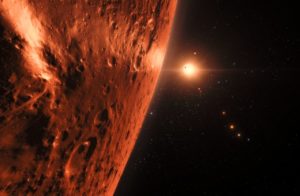In this planetarium show, students experience a digital journey into space, without ever leaving the comfort of their own chairs. A presenter, who is a student in astrophysics, geophysics, space technology or the like, takes the students on a journey to different planets in our solar system. The students learn about the necessary factors that are needed in order to create an environment suitable for life to exist. Throughout the show, the students are engaged in a dialogue, as the presenter asks questions and encourage the students to react by e.g., clapping their hands or shouting their answer in plenum.
After the planetarium show, the students watch the film “Touch the Stars”, which teaches the students about space exploration missions, which planet’s satellites have visited, and what data they have discovered.
Learning Objectives
The students are introduced to some of the greatest questions that humans have ever asked about space: Is there life out there? Can we permanently move to different worlds? How and why does the universe exist, and why do we exist? These questions are introduced to create interest and curiosity.
The students learn about the following key aspects:
- Life in space
- Planets
- Solar system
- Mars
- Satellites
- Space missions to new worlds
Setting Details
This activity is done within a dome theatre at a planetarium, in this case, the Planetarium in Copenhagen.
Materials needed
Digital planetarium system and a dome.
Script/programme of activity
10.00-10.45 Planetarium show about life in space presented in a dome theatre by a science communicator
10.45-10.55 Short break
10.55-11.45 The film ‘Touch the Stars’ is displayed on the dome
Teacher/educator
The teachers facilitate the students’ involvement by having the pedagogic responsibility where Planetarium facilitates the educational content.
Guardian
This activity does not in itself involve students’ families, but students are encouraged to talk about their experiences and space-related career paths with their families at home.
Researcher/invited expert
In this activity, the science communicators are the expert. They facilitate the educational content and represent role models as possible future astro-employees.
Key elements for inclusivenes
 This artist’s impression shows the view just above the surface of one of the planets in the TRAPPIST-1 system. At least seven planets orbit this ultracool dwarf star 40 light-years from Earth and they are all roughly the same size as the Earth. They are at the right distances from their star for liquid water to exist on the surfaces of several of them. This artist’s impression is based on the known physical parameters for the planets and stars seen, and uses a vast database of objects in the Universe.
This artist’s impression shows the view just above the surface of one of the planets in the TRAPPIST-1 system. At least seven planets orbit this ultracool dwarf star 40 light-years from Earth and they are all roughly the same size as the Earth. They are at the right distances from their star for liquid water to exist on the surfaces of several of them. This artist’s impression is based on the known physical parameters for the planets and stars seen, and uses a vast database of objects in the Universe.
The planetarium show does not require e.g., the ability to read and all types of students can participate in the activity. The narration of the film ‘Touch the Stars’ has been retranslated and recorded again with a focus on making the film easier to understand with fewer facts and in a more fluent language. The decision to retranslate the narration was based on feedback from teachers at a teacher course in which the film was piloted.

